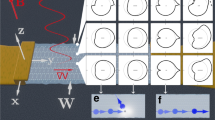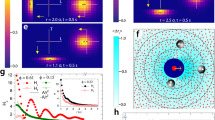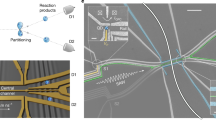Abstract
Hydrodynamics is a successful framework for effectively describing the dynamics of complex many-body systems, ranging from subnuclear to cosmological scales. It applies coarse-grained assumptions about the microscopic constituents of a system to define macroscopic fluid cells, which are large compared to the interparticle spacing and mean free path. In high-energy heavy-ion collisions, hydrodynamic behaviour is inferred from the observation of elliptic flow, which is the elliptical deformation of the particle momentum distribution. Here we demonstrate the emergence of elliptic flow in a mesoscopic system with a few strongly interacting ultracold atoms. In our system, a hydrodynamic description is a priori not applicable, as all relevant length scales—the system size, the interparticle spacing and the mean free path—are comparable. The single-particle resolution and the deterministic control over the number of particles and interaction strength in our experiment allow us to explore the boundaries between a microscopic description and a hydrodynamic framework, and we show that elliptic flow appears as an interaction-driven effect. Our results demonstrate the emergence of collective behaviour in a regime where hydrodynamics is not usually applicable.
This is a preview of subscription content, access via your institution
Access options
Access Nature and 54 other Nature Portfolio journals
Get Nature+, our best-value online-access subscription
$32.99 / 30 days
cancel any time
Subscribe to this journal
Receive 12 print issues and online access
$259.00 per year
only $21.58 per issue
Buy this article
- Purchase on SpringerLink
- Instant access to full article PDF
Prices may be subject to local taxes which are calculated during checkout



Similar content being viewed by others
Data availability
The data that support the findings in this study are available from the Zenodo repository, https://doi.org/10.5281/zenodo.11504182 (ref. 43). Source data are provided with this paper.
References
Ollitrault, J.-Y. Anisotropy as a signature of transverse collective flow. Phys. Rev. D 46, 229–245 (1992).
Braun-Munzinger, P. & Stachel, J. The quest for the quark-gluon plasma. Nature 448, 302–309 (2007).
Busza, W., Rajagopal, K. & van der Schee, W. Heavy ion collisions: the big picture and the big questions. Annu. Rev. Nucl. Part. Sci. 68, 339–376 (2018).
Poskanzer, A. M. & Voloshin, S. A. Methods for analyzing anisotropic flow in relativistic nuclear collisions. Phys. Rev. C 58, 1671–1678 (1998).
Bhalerao, R. S., Blaizot, J.-P., Borghini, N. & Ollitrault, J.-Y. Elliptic flow and incomplete equilibration at RHIC. Phys. Lett. B 627, 49–54 (2005).
O’Hara, K. M., Hemmer, S. L., Gehm, M. E., Granade, S. R. & Thomas, J. E. Observation of a strongly interacting degenerate Fermi gas of atoms. Science 298, 2179–2182 (2002).
Davis, K. B. et al. Bose-Einstein condensation in a gas of sodium atoms. Phys. Rev. Lett. 75, 3969–3973 (1995).
Trenkwalder, A. et al. Hydrodynamic expansion of a strongly interacting Fermi–Fermi mixture. Phys. Rev. Lett. 106, 115304 (2011).
Fletcher, R. J. et al. Elliptic flow in a strongly interacting normal Bose gas. Phys. Rev. A 98, 011601 (2018).
Abelev, B. et al. Long-range angular correlations on the near and away side in p-Pb collisions at \(\sqrt{{s}_{NN}}=5.02\) TeV. Phys. Lett. B 719, 29–41 (2013).
Aad, G. et al. Observation of associated near-side and away-side long-range correlations in \(\sqrt{{s}_{NN}}\) = 5.02 TeV proton-lead collisions with the ATLAS detector. Phys. Rev. Lett. 110, 182302 (2013).
Aidala, C. et al. Creation of quark–gluon plasma droplets with three distinct geometries. Nat. Phys. 15, 214–220 (2019).
Abdulhamid, M. I. et al. Measurements of the elliptic and triangular azimuthal anisotropies in central 3He + Au, d + Au and p + Au collisions at \(\sqrt{S_{NN}}=200\) GeV. Phys. Rev. Lett. 130, 242301 (2023).
Khachatryan, V. et al. Observation of long-range near-side angular correlations in proton-proton collisions at the LHC. J. High Energy Phys. 2010, 091 (2010).
Nagle, J. L. & Zajc, W. A. Small system collectivity in relativistic hadronic and nuclear collisions. Annu. Rev. Nucl. Part. Sci. 68, 211–235 (2018).
Schenke, B. The smallest fluid on Earth. Rep. Prog. Phys. 84, 082301 (2021).
Kurkela, A., Wiedemann, U. A. & Wu, B. Flow in AA and pA as an interplay of fluid-like and non-fluid like excitations. Eur. Phys. J. C 79, 965 (2019).
Ambrus, V. E., Schlichting, S. & Werthmann, C. Establishing the range of applicability of hydrodynamics in high-energy collisions. Phys. Rev. Lett. 130, 152301 (2023).
Serwane, F. et al. Deterministic preparation of a tunable few-fermion system. Science 332, 336–338 (2011).
Bayha, L. et al. Observing the emergence of a quantum phase transition shell by shell. Nature 587, 583–587 (2020).
Zürn, G. et al. Precise characterization of 6Li Feshbach resonances using trap-sideband-resolved RF spectroscopy of weakly bound molecules. Phys. Rev. Lett. 110, 135301 (2013).
Petrov, D. S. & Shlyapnikov, G. V. Interatomic collisions in a tightly confined Bose gas. Phys. Rev. A 64, 012706 (2001).
Holten, M. et al. Observation of Cooper pairs in a mesoscopic two-dimensional Fermi gas. Nature 606, 287–291 (2022).
Brandstetter, S. et al. Magnifying the wave function of interacting fermionic atoms. Preprint at https://arxiv.org/abs/2409.18954 (2024).
Bergschneider, A. et al. Spin-resolved single-atom imaging of 6Li in free space. Phys. Rev. A 97, 063613 (2018).
Pitaevskii, L & Stringari, S. Bose-Einstein Condensation and Superfluidity (Oxford Univ. Press, 2016).
Schäfer, T & Chafin, C. in The BCS-BEC Crossover and the Unitary Fermi Gas. Lecture Notes in Physics, Vol. 836 (ed. Zwerger, W.) 375–406 (Springer, 2012).
Makhalov, V., Martiyanov, K. & Turlapov, A. Ground-state pressure of quasi-2D Fermi and Bose gases. Phys. Rev. Lett. 112, 045301 (2014).
Von Weizsaecker, C. F. Zur theorie der kernmassen. Z. Phys. 96, 431–458 (1935).
Salasnich, L., Comaron, P., Zambon, M. & Toigo, F. Collective modes in the anisotropic unitary Fermi gas and the inclusion of a backflow term. Phys. Rev. A 88, 033610 (2013).
Floerchinger, S., Giacalone, G., Heyen, L. H. & Tharwat, L. Qualifying collective behavior in expanding ultracold gases as a function of particle number. Phys. Rev. C 105, 044908 (2022).
Giorgini, S., Pitaevskii, L. P. & Stringari, S. Theory of ultracold atomic Fermi gases. Rev. Mod. Phys. 80, 1215–1274 (2008).
Menotti, C., Pedri, P. & Stringari, S. Expansion of an interacting Fermi gas. Phys. Rev. Lett. 89, 250402 (2002).
Malvania, N. et al. Generalized hydrodynamics in strongly interacting 1D Bose gases. Science 373, 1129–1133 (2021).
Andronic, A., Braun-Munzinger, P., Redlich, K. & Stachel, J. Decoding the phase structure of QCD via particle production at high energy. Nature 561, 321–330 (2018).
Grebenev, S., Toennies, J. P. & Vilesov, A. F. Superfluidity within a small helium-4 cluster: the microscopic Andronikashvili experiment. Science 279, 2083–2086 (1998).
Palm, L., Grusdt, F. & Preiss, P. M. Skyrmion ground states of rapidly rotating few-fermion systems. New J. Phys. 22, 083037 (2020).
Abraham, E. R. I. et al. Singlet s-wave scattering lengths of 6Li and 7Li. Phys. Rev. A 53, R3713–R3715 (1996).
Asteria, L., Zahn, H. P., Kosch, M. N., Sengstock, K. & Weitenberg, C. Quantum gas magnifier for sub-lattice-resolved imaging of 3D quantum systems. Nature 599, 571–575 (2021).
Landau, L. & Lifshitz, E. Fluid Mechanics (Pergamon Press, 1987).
Levinsen, J. & Parish, M. M. in Annual Review of Cold Atoms and Molecules, Vol. 3 (eds Madison K. W et al.) 1–75 (World Scientific Publishing, 2015).
Harpole, A., Zingale, M., Hawke, I. & Chegini, T. pyro: a framework for hydrodynamics explorations and prototyping. J. Open Source Softw. 4, 1265 (2019).
Brandstetter, S. et al. Emergent interaction-driven elliptic flow of few fermionic atoms – data repository. Zenodo https://doi.org/10.5281/zenodo.11504182 (2024).
Acknowledgements
We gratefully acknowledge insightful discussions with T. Enss, A. Mazeliauskas and J.-Y. Ollitrault. This work has been supported by the Heidelberg Center for Quantum Dynamics, the DFG Collaborative Research Centre SFB 1225 (ISOQUANT) (S.F. and S.J.), the DFG project DFG FL 736/3-1 (NEQFluids) (S.F.), Germany’s Excellence Strategy EXC2181/1-390900948 (Heidelberg Excellence Cluster STRUCTURES) (S.J.) and the European Union’s Horizon 2020 research and innovation programme (Grant Agreement Nos. 817482 (PASQuanS) and 725636 (ERC QuStA), both to S.J.). This work has been partially financed by the Baden-Württemberg Stiftung (P.M.P. and S.J.).
Author information
Authors and Affiliations
Contributions
S.B., P.L, C.H. and S.J conceived the experiment. S.B. and C.H. performed the measurements. P.L., S.B. and C.H. analysed the data. S.J. supervised the experimental part of the project. S.F., G.G. and L.H.H. set up and ran the hydrodynamic simulations. S.B. and P.L. wrote the paper with input from all authors. All authors contributed to the discussion of the results.
Corresponding authors
Ethics declarations
Competing interests
The authors declare no competing interests.
Peer review
Peer review information
Nature Physics thanks the anonymous reviewers for their contribution to the peer review of this work.
Additional information
Publisher’s note Springer Nature remains neutral with regard to jurisdictional claims in published maps and institutional affiliations.
Extended data
Extended Data Fig. 1 Initial system.
We prepare our initial system in a 2D harmonic oscillator. a The confinement is given by the overlap of a 2D light sheet (2D ODT) and a vertical optical tweezer (OT) with elliptical beamshape. b The resulting level scheme of the non-interacting system is characterized by two quantum numbers (nx, ny). Shown is a closed shell configuration of 5+5 atoms. The Fermi energy is the energy of the highest occupied level. c By lowering the trap depth, the particles leave the trap shell by shell. Counting the number of atoms as a function of the optical trap depth reveals the level structure of the system. For the weakly-interacting system we find, corresponding to B, filled shells of 1+1, 2+2, 3+3, 5+5 and 7+7 atoms.
Extended Data Fig. 2 Momentum space density of 5+5 non-interacting atoms.
Comparison of the experimental and theoretical (a and b, respectively) momentum space density of 5+5 non-interacting atoms in our elliptical trap. The pixel size is given by the pixel size of our camera.
Extended Data Fig. 3 Integrated momentum space density of 5+5 non-interacting atoms.
The measured and the calculated momentum density gets integrated along y- and x- direction (a and b, respectively). In the errors, the theoretical curve coincides with the experimental curves, showing that the non-interacting system is in the ground state of the harmonic oscillator potential.
Extended Data Fig. 4 Ballistic expansion.
Root mean square of the atom positions δrx,y as a function of tint. The dashed lines show the expected ballistic expansion, the solid lines mark the ideal hydrodynamic evolution of the corresponding many-body system.
Source data
Rights and permissions
Springer Nature or its licensor (e.g. a society or other partner) holds exclusive rights to this article under a publishing agreement with the author(s) or other rightsholder(s); author self-archiving of the accepted manuscript version of this article is solely governed by the terms of such publishing agreement and applicable law.
About this article
Cite this article
Brandstetter, S., Lunt, P., Heintze, C. et al. Emergent interaction-driven elliptic flow of few fermionic atoms. Nat. Phys. 21, 52–56 (2025). https://doi.org/10.1038/s41567-024-02705-8
Received:
Accepted:
Published:
Issue date:
DOI: https://doi.org/10.1038/s41567-024-02705-8
This article is cited by
-
Odd-parity effect and scale-dependent viscosity in atomic quantum gases
Communications Physics (2025)
-
Fluids constructed atom by atom
Nature Physics (2025)



